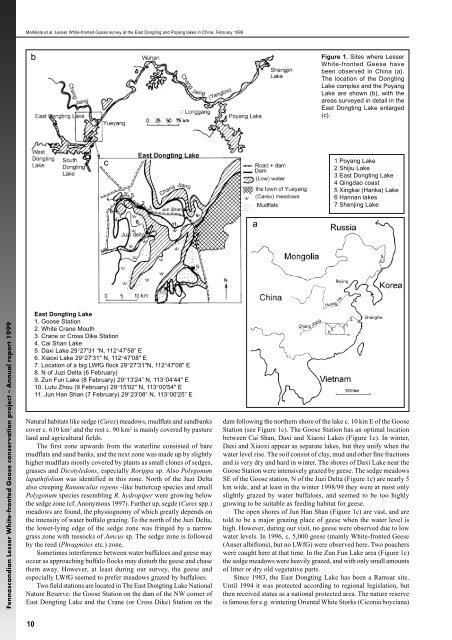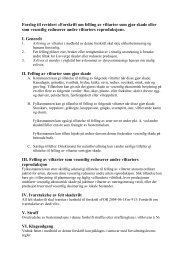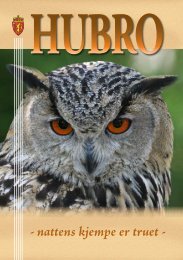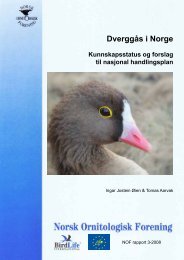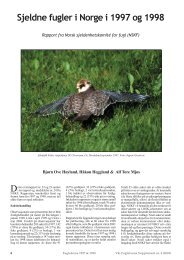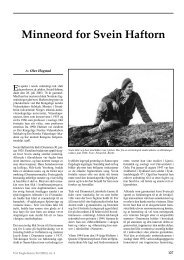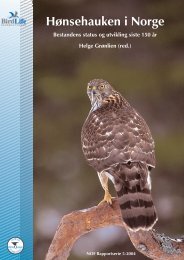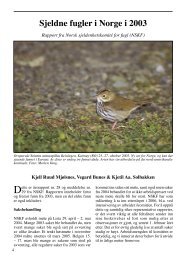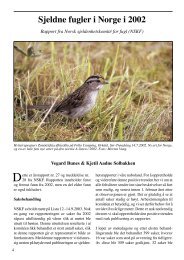Fennoscandian Lesser White-fronted Goose conservation project ...
Fennoscandian Lesser White-fronted Goose conservation project ...
Fennoscandian Lesser White-fronted Goose conservation project ...
You also want an ePaper? Increase the reach of your titles
YUMPU automatically turns print PDFs into web optimized ePapers that Google loves.
<strong>Fennoscandian</strong> <strong>Lesser</strong> <strong>White</strong>-<strong>fronted</strong> <strong>Goose</strong> <strong>conservation</strong> <strong>project</strong> – Annual report 1999<br />
Markkola et al: <strong>Lesser</strong> <strong>White</strong>-<strong>fronted</strong> <strong>Goose</strong> survey at the East Dongting and Poyang lakes in China, February 1999<br />
b<br />
Natural habitats like sedge (Carex) meadows, mudflats and sandbanks<br />
cover c. 610 km 2 and the rest c. 90 km 2 is mainly covered by pasture<br />
land and agricultural fields.<br />
The first zone upwards from the waterline consisted of bare<br />
mudflats and sand banks, and the next zone was made up by slightly<br />
higher mudflats mostly covered by plants as small clones of sedges,<br />
grasses and Dicotyledons, especially Rorippa sp. Also Polygonum<br />
lapathifolium was identified in this zone. North of the Juzi Delta<br />
also creeping Ranunculus repens -like buttercup species and small<br />
Polygonum species resembling R. hydropiper were growing below<br />
the sedge zone (cf. Anonymous 1997). Further up, segde (Carex spp.)<br />
meadows are found, the physiognomy of which greatly depends on<br />
the intensity of water buffalo grazing. To the north of the Juzi Delta,<br />
the lower-lying edge of the sedge zone was fringed by a narrow<br />
grass zone with tussocks of Juncus sp. The sedge zone is followed<br />
by the reed (Phragmites etc.) zone.<br />
Sometimes interference between water buffaloes and geese may<br />
occur as approaching buffalo flocks may disturb the geese and chase<br />
them away. However, at least during our survey, the geese and<br />
especially LWfG seemed to prefer meadows grazed by buffaloes.<br />
Two field stations are located in The East Dongting Lake National<br />
Nature Reserve: the <strong>Goose</strong> Station on the dam of the NW corner of<br />
East Dongting Lake and the Crane (or Cross Dike) Station on the<br />
10<br />
c<br />
East Dongting Lake<br />
1. <strong>Goose</strong> Station<br />
2. <strong>White</strong> Crane Mouth<br />
3. Crane or Cross Dike Station<br />
4. Cai Shan Lake<br />
5. Daxi Lake 29°27'31 “N, 112°47'58” E<br />
6. Xiaoxi Lake 29°27'31" N, 112°47'08" E<br />
7. Location of a big LWfG flock 29°27'31"N, 112°47'08" E<br />
8. N of Juzi Delta (6 February)<br />
9. Zun Fun Lake (8 February) 29°13'24” N, 113°04'44" E<br />
10. Lutu Zhou (9 February) 29°15'02" N, 113°00'54" E<br />
11. Jun Han Shan (7 February) 29°23'08“ N, 113°00'25” E<br />
a<br />
Figure 1. Sites where <strong>Lesser</strong><br />
<strong>White</strong>-<strong>fronted</strong> Geese have<br />
been observed in China (a).<br />
The location of the Dongting<br />
Lake complex and the Poyang<br />
Lake are shown (b), with the<br />
areas surveyed in detail in the<br />
East Dongting Lake enlarged<br />
(c).<br />
1 Poyang Lake<br />
2 Shijiu Lake<br />
3 East Dongting Lake<br />
4 Qingdao coast<br />
5 Xingkai (Hanka) Lake<br />
6 Hannan lakes<br />
7 Shenjing Lake<br />
dam following the northern shore of the lake c. 10 km E of the <strong>Goose</strong><br />
Station (see Figure 1c). The <strong>Goose</strong> Station has an optimal location<br />
between Cai Shan, Daxi and Xiaoxi Lakes (Figure 1c). In winter,<br />
Daxi and Xiaoxi appear as separate lakes, but they unify when the<br />
water level rise. The soil consist of clay, mud and other fine fractions<br />
and is very dry and hard in winter. The shores of Daxi Lake near the<br />
<strong>Goose</strong> Station were intensively grazed by geese. The sedge meadows<br />
SE of the <strong>Goose</strong> station, N of the Juzi Delta (Figure 1c) are nearly 5<br />
km wide, and at least in the winter 1998/99 they were at most only<br />
slightly grazed by water buffaloes, and seemed to be too highly<br />
growing to be suitable as feeding habitat for geese.<br />
The open shores of Jun Han Shan (Figure 1c) are vast, and are<br />
told to be a major grazing place of geese when the water level is<br />
high. However, during our visit, no geese were observed due to low<br />
water levels. In 1996, c. 5,000 geese (mainly <strong>White</strong>-<strong>fronted</strong> Geese<br />
(Anser albifrons), but no LWfG) were observed here. Two poachers<br />
were caught here at that time. In the Zun Fun Lake area (Figure 1c)<br />
the sedge meadows were heavily grazed, and with only small amounts<br />
of litter or dry old vegetative parts.<br />
Since 1983, the East Dongting Lake has been a Ramsar site.<br />
Until 1994 it was protected according to regional legislation, but<br />
then received status as a national protected area. The nature reserve<br />
is famous for e.g. wintering Oriental <strong>White</strong> Storks (Ciconia boyciana)


